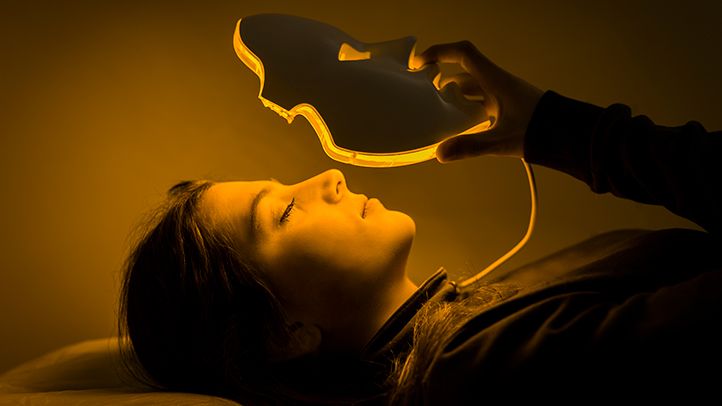LED light therapy devices, including masks, have the potential to give you smoother, clearer skin. Read this before trying the skin-care trend.
When people talk about “the future of skincare,” I don’t think any of us predicted something quite so futuristic. Whether you’re a serial Instagram scroller or just have your thumb on the pulse of the newest, coolest skincare innovations, you’ve probably heard a little something about LED skin therapy. In the past, these fancy treatments were only available under the practiced hand of your aesthetician for in-office treatments. Now, this luxury is available for you to use at your leisure when your skin is in the mood for something fancy.
What does LED light therapy do?
LED light therapy is actually a NASA technology that was adopted by the skincare community, thanks to its ability to heal wounds and tame inflammation. Blue light frequencies are typically used to treat acne, while red light is used for anti-aging concerns. At-home devices are less powerful than the treatments you’d get at a dermatologist’s office, which means you can use them safely but it may take longer to see visible results.
Is LED light therapy safe?
Overall, they’re pretty safe, the experts said. Many are cleared by the FDA, though that speaks to their safety more than their efficacy.
People may confuse LED with ultraviolet light, but the two are very different. UV light can damage DNA, while there’s no evidence that could happen with LED light, Avram said.
But he and Gohara urged people to protect their eyes when using the devices. In 2019, Neutrogena recalled its Light Therapy Acne Mask “out of an abundance of caution” because of a “theoretical risk of eye injury” for people with certain eye conditions. Others reported visual effects when using the mask.
The verdict is out on how much human-made blue light is “too much blue light” for the eyes, said Dr. Barbara Horn, past president of the American Optometric Association.
“Most of these masks have the eyes cut out so that the light is not directed into the eye. However, for any type of light therapy treatment, eye protection is highly recommended,” she noted. “While at-home masks may have a lesser intensity, there may be some short-wavelength visible light that could spill over in close proximity to the eye.”
Any potential eye problems could also correlate to how long the masks are being worn, what intensity the LED light is and whether users have their eyes open while wearing them, the optometrist said.
Research the quality of the product and follow the safety instructions and manufacturer guidelines before using any of these devices, she advised. Gohara recommended wearing sunglasses or opaque glasses for extra eye protection.
What Does an LED Mask Do to Your Skin?
“LED therapy uses light in the visible spectrum – including blue, yellow, amber and red – as well as light beyond the visible spectrum to penetrate different depths of skin. As the light wavelength increases, so does the depth of penetration,” explains Dr. Gross. This light is absorbed by receptors in the skin, just like topical skincare, and each colour of light stimulates a different response in the skin. LED is suitable for use on all skin types and tones.
Do LED Masks Actually Work?
The research behind LED masks is centered on the lights used, and if you’re going on those findings, LED masks can be beneficial to your skin.
For instance, in a March 2017 study in Dermatologic Surgery of more than 50 women, researchers found that red LED light treatment improved measures of eye-area wrinkles.
When it comes to acne, a March/April 2017 issue of Clinics in Dermatology that reviewed available research noted that red and/or blue light therapy for acne reduced blemishes by 46 to 76 percent after 4 to 12 weeks of treatment. That said, other research on blue light, like a review in the Annals of Family Medicine in November/December 2019, are far less promising when it comes to blue light’s ability to clear skin.
Research shows that blue light penetrates skin’s hair follicles and pores. “Bacteria can be very susceptible to the blue light spectrum. It stops their metabolism and kills them,” says Solomon. This is advantageous for preventing future breakouts. “Unlike topical treatments that work to ease inflammation and bacteria on the surface of the skin, light treatment eliminates the acne-causing bacteria in the skin before it begins to feed on the oil glands, causing redness and inflammation,” she adds. Because red light reduces inflammation, it also may be used in combination with blue light to address acne.
But it’s helpful to keep your expectations in check. “Not all at-home devices deliver the same strength that a clinical device can. What can be accomplished at home will not always have the same effect as what can be achieved at a dermatologist’s office, where treatment is calibrated and regulated,” says Solomon.
Another consideration is that you have a good skin-care regimen set in place to act in conjunction with light therapy. “This isn’t a good monotherapy. Light devices can help as long as they’re used with topicals or in-office treatments,” says Dr. Farber.
Are There Any Risks to Using LED Masks?
In general, LED masks are safe. There are exceptions to this rule, though. Be sure to follow these tips before trying one:
Do Your Research
Be sure that the mask you choose is safe. One of the more popular LED masks, made by Neutrogena, is currently under recall, as there are concerns of a “theoretical risk of eye injury” from the lights for some folks who have eye conditions or take certain medication. Wearing eye protection when using the device is good advice for anyone, says Farber.
Salomon advises making sure that the LED light therapy device you buy is labeled as FDA-cleared.
The Effects of Blue Light Are Murky
Some experts are also wary of blue light exposure. A study published in July 2017 in Free Radical Biology & Medicine suggests that blue light can cause free radical damage, which breaks down skin’s structures and leads to aging, and yet other colors of light, such as red and green, did not.
“There are questions about whether or not people should be using blue light or if it can be damaging to skin. I think that’s something we need more information on,” says Farber. The exact role these devices that emit blue light for acne may play in that process is yet to be seen. Still, with that in mind, you may choose to hold off on the blue light treatment for now.


